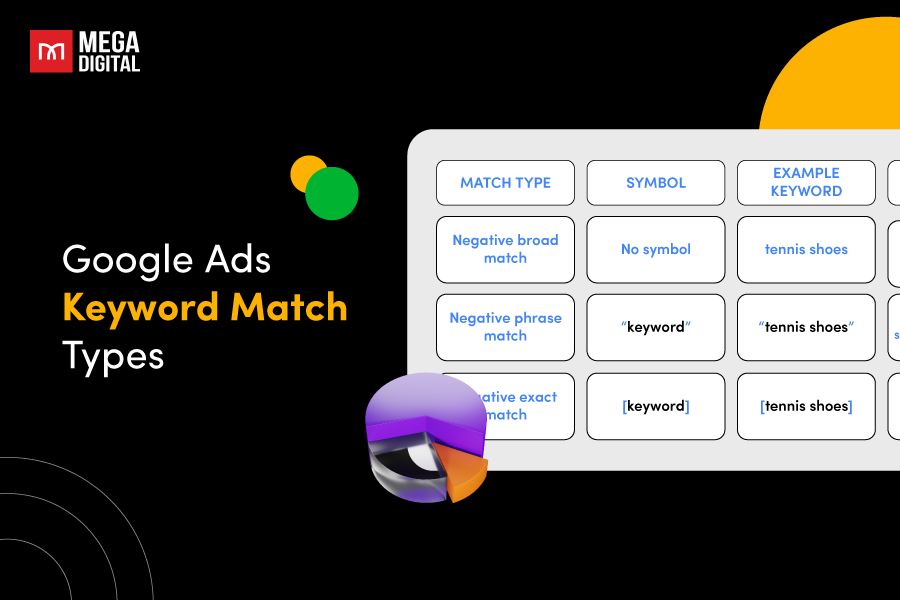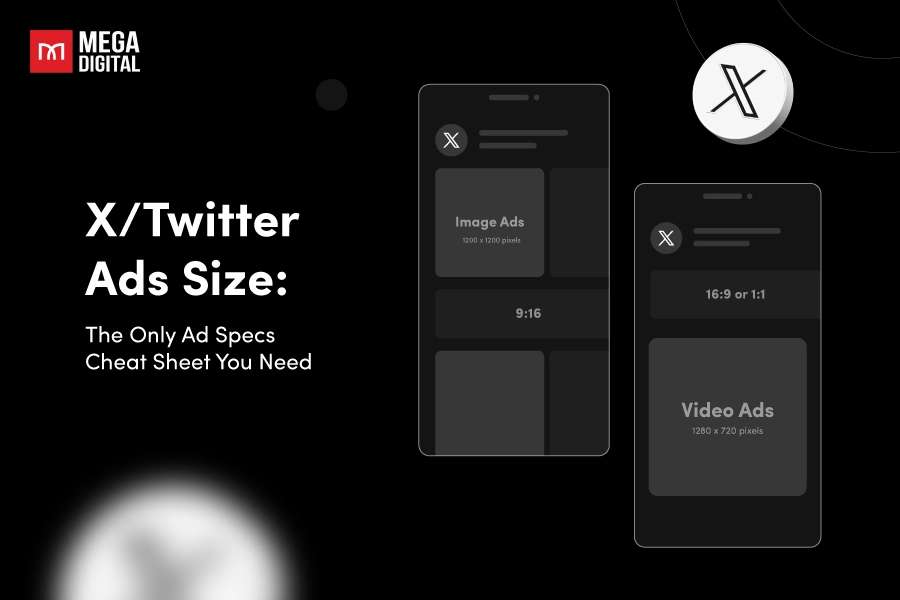Google Ads audience targeting stands tall as the key that unlocks the door to reaching the right people at the right time. If you’re eager to improve ad performance and reach your target audience, Mega Digital hereby presents a list of all effective strategies that would satisfy your demand.
What is Google Ads audience targeting?
Google Ads audience is also known as ‘‘audience lists”, ‘‘user lists”, or ‘‘data segments”.
In other words, Google Ads audiences refer to distinct segments of potential customers that you can tailor your ads to reach, aligning with your business’s specifics. These groups comprise individuals within your intended customer base. Google Ads audience targeting shaped these audience categories around interests, hobbies, engagement with your brand, and search behaviors.
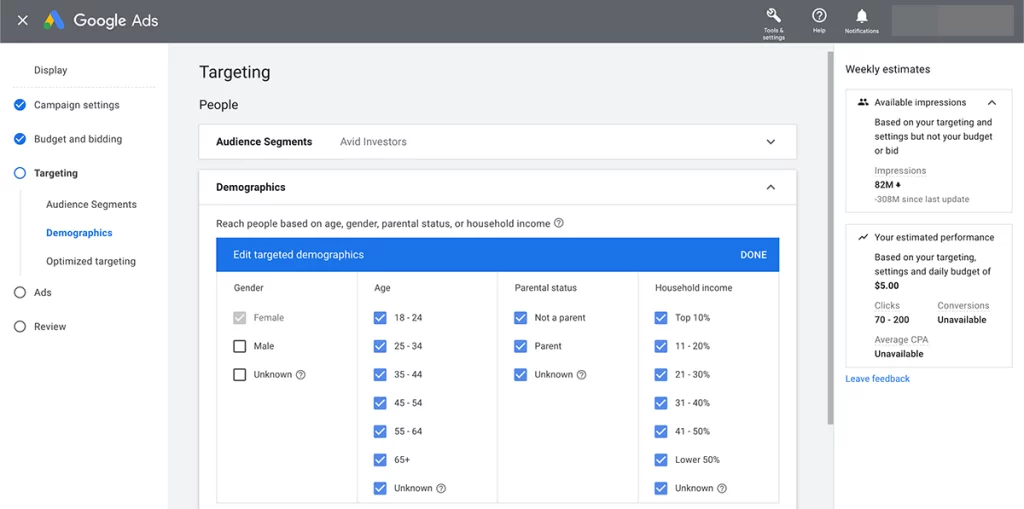
How do audience segments function?
In different Google Ads campaigns (like Search, Display, and Standard Shopping), audiences are specific groups of people with certain interests, intents, and demographics identified by Google. When you add an audience to your campaign or ad group, you can pick from various segments.
For example, these audiences in Google Ads could include music and movie fans, car shoppers, or people who visited your site or app. Google Ads then displays ads to those likely to be in these chosen categories based on their activity on Google products and other websites or estimated interests in the content.
Additionally, the user’s behavior toward Google products and third-party websites defines audiences, or marketers approximate these audiences based on content expected to interest specific demographics.
Types of audiences in Google Ads
Based on our research, we divide Google Ads audience targeting into 4 main groups:
- Google’s audience segments
- Custom segments
- Your data segments
- Other segments
Let’s take a closer look at each.

1. Google’s audience segments
Google has four standard audience categories that any advertiser can access. They’re the quickest and simplest way to start using audiences in your campaigns.
Detailed demographic targeting
Demographics usually include coverage, gender, and parental status. Detailed demographic segments are larger groups of people who share similar characteristics. Examples of these segments include college students, homeowners, or new parents.
Examples:
- Marital status: Married
- Homeownership status: Renters
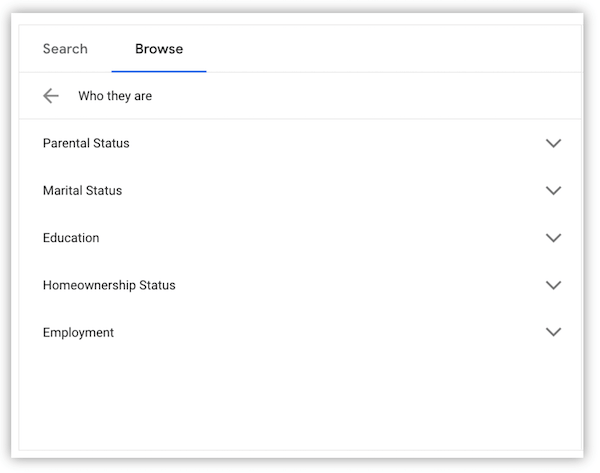
Affinity audiences targeting
Target users based on a comprehensive understanding of their lifestyles, interests, and behaviors. Affinity segments are currently available to all Google advertisers in standard shopping, video, Gmail, display and video 360, and search campaigns.
Examples:
- Banking & Finance
- Vlogging

In-market segment targeting
High-intent prospecting campaigns benefit from in-market segments as individuals move in and out of these segments based on their purchasing habits. Advertisers aiming to target potential customers with higher chances of conversions find in-market segments particularly advantageous. These segments specifically focus on customers who are nearing the completion of a purchase.
Examples:
- SEO & SEM services
- IELTS courses
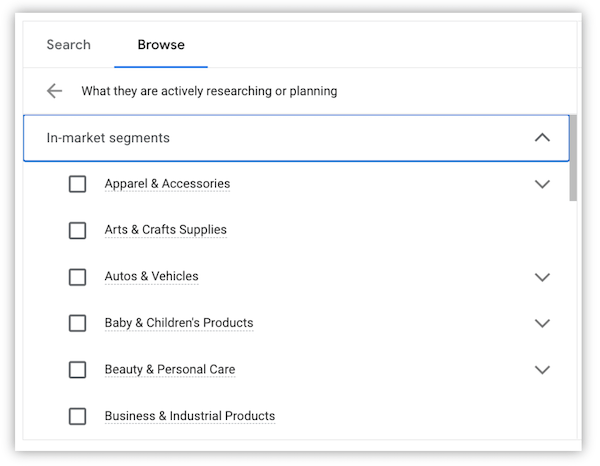
Life event targeting
Life events, like other significant turning points, are not frequent and, therefore, may appeal to a smaller audience than affinities. However, the segment is frequently larger than the in-market segment, which corresponds with a single purchasing decision, because life events may correspond with multiple related purchasing decisions. A person who is planning to move out, for instance, is probably going to purchase new furniture, moving equipment, mortgages, and other moving-related items in the months of their move.
Examples:
- Getting married soon.
- Graduation presents.
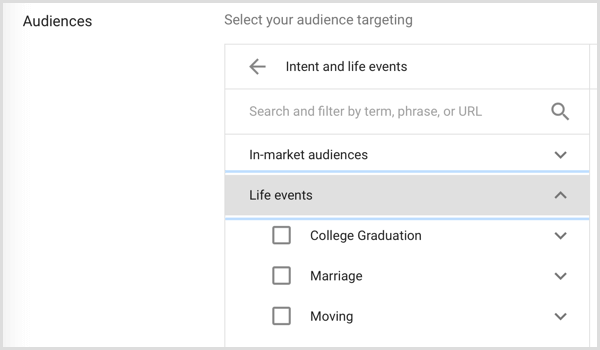
2. Customs segments
Custom segments allow you to reach your target audience by inserting relevant keywords, URLs, and apps. By including particular keywords, URLs, and apps associated with your goods or services, you can create a custom segment in your Display, Discovery, Gmail, and Video campaigns.
Once confirming compliance with Google Ads’ policies on advertising, ads relevant to these interests or intended purchases will appear on websites, applications, and videos for users demonstrating these specific interests.

Then the system will analyze all of those signals, assuming your bidding strategy and campaign goals, and select a segment that focuses on one of the following:
- Reach
- Consideration
- Performance
Examples:
A running shoe company might want to target Avid Marathon Runners rather than the Sports Fan’s affinity group. The shoe company can specify this segment using a custom segment: Entering terms such as “long-distance runner”, “triathlon athlete”, or “5K in San Francisco”. Utilizing website addresses that contain information on training plans, marathon nutrition, running, and other marathon-related topics, launch apps.
3. Your data segments
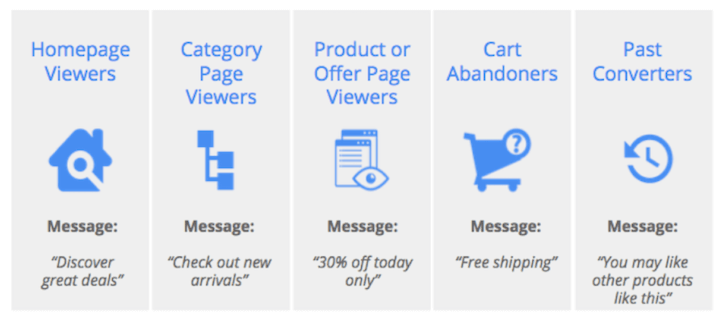
Your data segments, formerly known as “remarketing,” include:
- People who have viewed your apps or website.
- Customers who have given you their personal information. Through Search, Shopping, Gmail, Standard Shopping, YouTube, and Display, you can reach and re-engage your customers with the help of this online and offline data.
- Those with comparable interests to those of your customers Google Ads automatically updates related segments for relevancy by comparing new users to the customer segments and data you supply. It automatically removes your original segment from your similar segment to prevent overlap.
Remarketing audiences
Google Ads offers four different types of remarketing audiences:
- Users who have interacted with your website are listed on your website.
- Users who have interacted with your app are listed in your app.
- Users who have interacted with your YouTube channel or content are listed on YouTube.
- Users who have provided you with their personal information (phone number, email address, etc.).
Similar segment audiences
These are lists of users who exhibit similar online behavior to those on your remarketing lists. They are also known as lookalikes or similar audiences.
Users who are new to your business and who share traits and behaviors with your best customers, for instance, are more likely to be interested in becoming your customers and appear on a similar segment created from your Most Profitable Customers list.
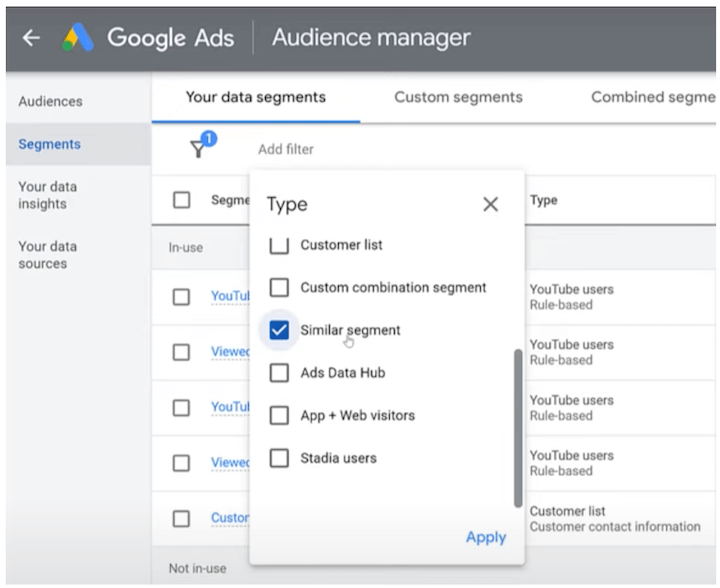
4. Other Google Ads audiences targeting
Google Ads gives you even more audience targeting options besides Google’s audience segments, your data segments, and custom segments.
Optimized targeting
By utilizing Google’s machine learning capabilities for optimized targeting, you can discover new audiences who have the potential to assist you in achieving your objectives.
Optimized targeting at the ad group level will be automatically selected for you when you create a Discovery, Display, or YouTube campaign. To get a better CPA, ROAS, or whatever metric your bid strategy is optimized for, you should let the computer programs do what they do best, which is find pockets of opportunity. This is the goal of optimized targeting.
Combined segment targeting
Finally, with Google Ads combined segments, you can create an audience of individuals who meet more than one audience targeting requirement. A customized segment may also be included in a combined segment.
You could, for instance, gather a group of individuals who are not on the customer’s list or website remarketing list but are in the market for luxury goods as well as athletic shoes or activewear.
How to set up your Google Ads audience targeting
There are several steps to setting up Google Ads audience targeting:
Step 1: Access Google Ads

Log in to your Google Ads account and select the campaign you want to edit or create a new one.
Step 2: Define Your Audience
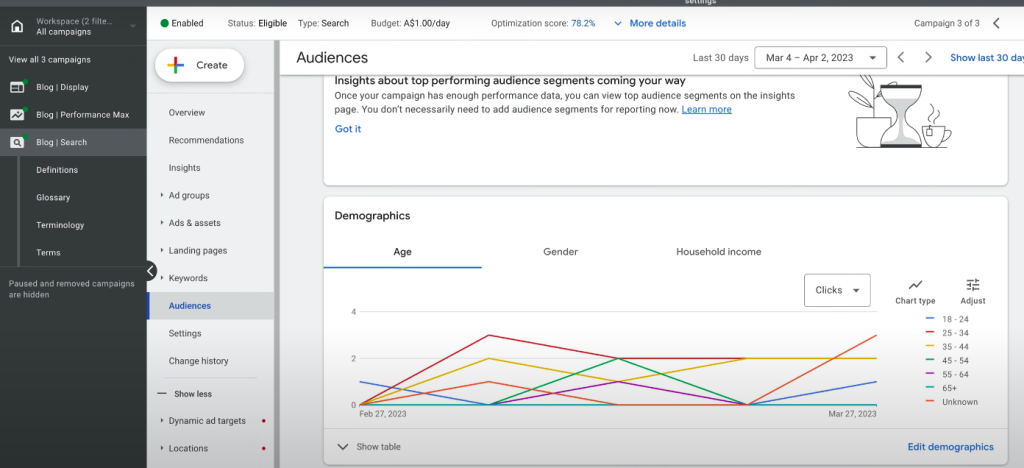
Determine who your ideal customers are based on demographics (age, gender, income), interests, behaviors, and other criteria.
Step 3: Choose Targeting Method
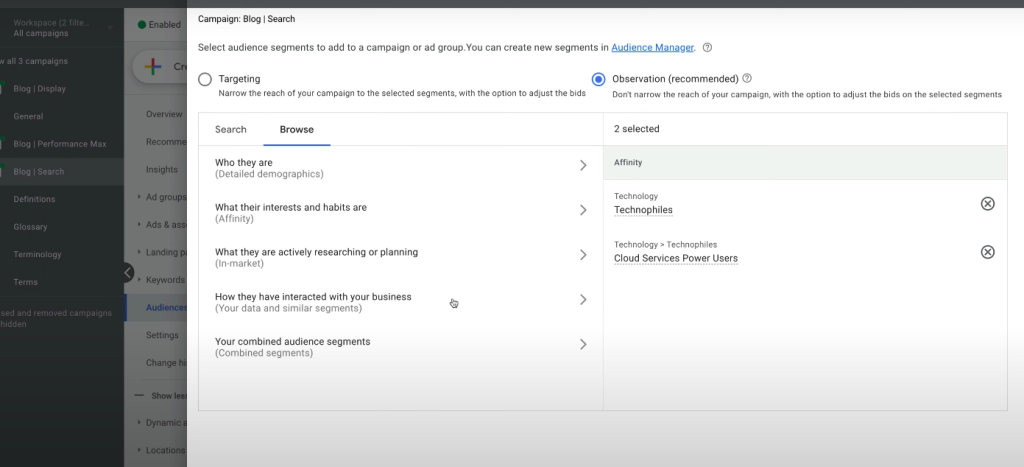
Navigate to the campaign settings and select the ad group where you want to set up targeting. You’ll find options for targeting, such as:
- Keywords: Specify relevant keywords to trigger your ads.
- Location: Target specific geographic locations.
- Audiences: Define specific audiences based on demographics, interests, or behaviors.
- Devices: Choose to target specific devices like mobile, desktop, or tablets.
- Demographics: Target based on age, gender, parental status, etc.
- Remarketing: Target users who have previously interacted with your site or app.
Step 4: Save and Review
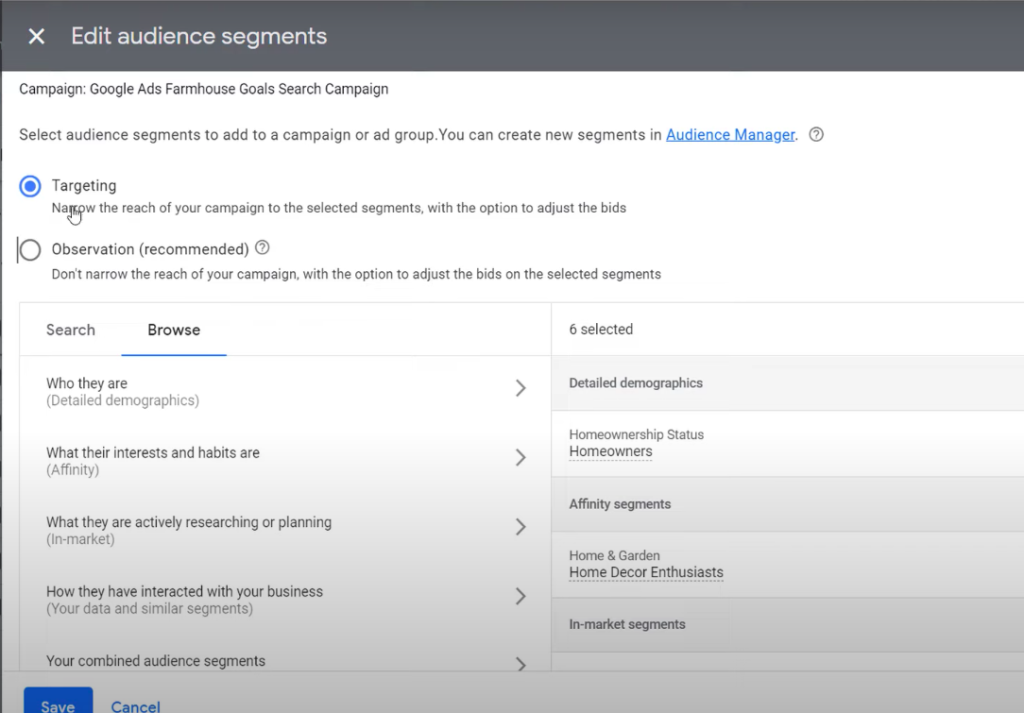
Click the checkbox to confirm your audience choice, and then click “Save.”
To sum up, you can modify your PPC campaigns by using these steps to target the most appropriate demographic for your campaign.
5 Tips for using Google Ads audience targeting
After understanding all types of Google Ads audiences, here are 5 keys for you to leverage Google Ads audience targeting effectively.
Understand your audience
Clearly identify and investigate your target audience. Understand their preferences, interests, behaviors, and demographics. The better you understand your audience, the more accurately you can target them.
Avoid over-segmenting your target audience
When using Google Ads audiences, start with a couple of broader audience groups instead of diving into niche segments right away. After running ads and seeing what works, gradually segment your audience into smaller groups for better targeting and improved results.
Regularly refine and test
Analyze your audience targeting performance on a regular basis. Using the data and insights from your campaigns, test various audience segments, modify bids, and improve targeting.
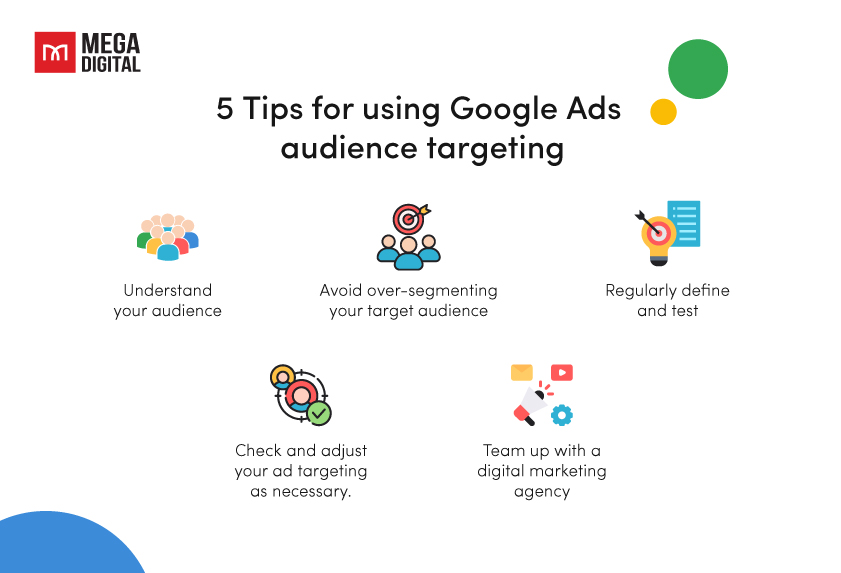
Check and adjust your ad targeting as necessary
Pay attention to the performance metrics of your campaigns, including click-through rates, conversions, and return on investment. To continuously optimize results, make adjustments to your audience-targeting strategy based on the data. It is necessary to experiment with various ad targeting options with Google Ads audience targeting in order to determine which ones are most effective for your website.
Even though you may believe that a certain kind of targeting is more appealing to your audience, you may discover that it doesn’t lead to success. To get the best results, it’s essential to test your plan and make any necessary adjustments.
Team up with a digital marketing agency
If you find it difficult to identify and adjust the best audience targeting for your campaign, you should consider collaborating with a Google Premier Partner agency, like us. Mega Digital will provide insightful analysis and useful tactics that will improve the performance of your campaigns by improving audience targeting and overall campaign performance. Engaging with experts in the field can greatly produce better advertising results.
Wrap up
Google Ads audience targeting allows you to connect with individuals interested in your company in innovative ways. Optimizing your Google Ads audience targeting involves focusing on understanding your audience, experimenting with diverse targeting strategies, and consistently refining based on performance metrics.
Should you face uncertainty in identifying the right audience or struggle to find a suitable agency, Mega Digital is here to help. As a Google Premier Partner, our team of over 100 experts guarantees a satisfying PPC campaign tailored to your needs.







